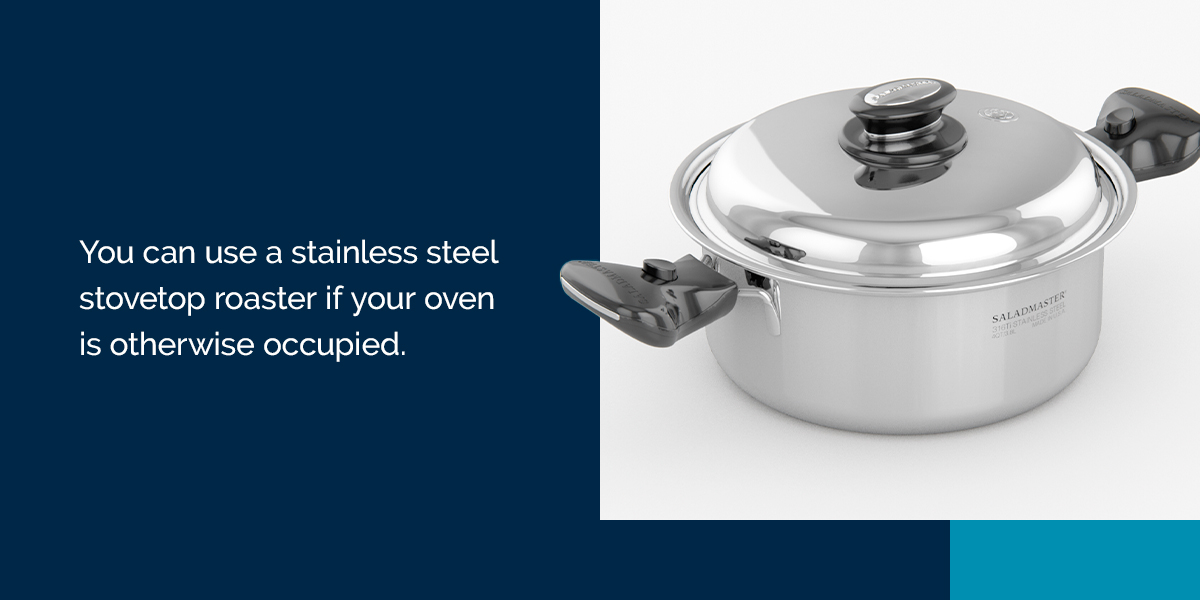Healthy Cooking Methods and Techniques
You're already choosing healthy foods, but are you choosing the healthiest cooking methods? Learn how to make the most of your ingredients with Saladmaster.
What we eat has an enormous impact on the way we feel, and maintaining a healthy diet keeps our minds and bodies performing at their best. Most of us already know the basics of healthy eating — follow the food pyramid, aim for whole foods and limit sugar, sodium and oil.
You care about your health, so you start out with the best ingredients. Your kitchen is stocked with whole grains, local organic produce and fresh free-range eggs from the farmers market. However, how you cook your food is just as important as what you cook.
Cooking makes food easier to digest and increases nutrient absorption. However, it also reduces some nutrients' availability. Heat-sensitive and water-soluble vitamins like vitamins C and B are especially at risk with certain cooking methods. Choosing healthy ways to prepare food will let you maintain as much of your food's nutritional content as possible.
Let's take a look at some healthy cooking methods to help you make the most of your meals.
The Healthiest Ways to Cook Food
What's the best method of cooking food? The answer can vary depending on your own health, preferences and available time. However, any method that makes it easier for you to cook healthy, delicious food is one you'll want to try.
We've collected our top four healthy cooking methods here. Choose your favorite, or add them all to your cooking library!
1. Braising
Braising is really two cooking methods — sauteeing and slow-cooking — rolled into one. You'll saute the food over high heat until it's browned on all sides, then cook it slowly in a covered dish.
Most braising recipes call for additional liquid, but you may want to experiment with both wet and dry braising:
- Wet: For this more common type of braising, you add liquid to the dish and simmer your ingredients in a low-temperature oven.
- Dry: If your ingredients are tender enough, you can use a dry braising technique instead. Instead of adding liquid, dry braising only uses the moisture the food releases as it cooks.
As with other liquid cooking methods, wet braising will leach some of the vitamin content out of the food. However, since you typically also consume the broth these recipes create, you won't lose any of the nutritional value.
2. Broiling
Broiling involves cooking food directly under a high-temperature heat source. This method cooks food quickly and is suitable for everything from pork chops to vegetables to skinless chicken breasts. It's also an especially healthy way to cook high-fat meats like beef or fish.
While the design can differ from oven to oven, most broilers feature a broiling rack and pan below a heat source — either a heating element or an open flame. This method is a bit like upside-down grilling. Like grilling, broiling cooks out saturated fats and lets you achieve a deliciously crisped exterior without adding oil. However, instead of dripping into an open grill, the rendered fat collects in the broiling pan for easy disposal.
3. Roasting

Like broiling and dry braising, roasting uses dry heat, helping preserve your food's vitamins and other nutrients.
Roasting uses high temperatures to surround the food with hot, dry air. While an oven is most common, you can use any system that provides a similar environment. You can use a stainless steel stovetop roaster if your oven is otherwise occupied. A backyard fire pit will also create a consistently dry, hot atmosphere for spit-roasting.
This method encourages even cooking on all sides to bring out the flavor in foods like:
- Whole chickens or turkeys
- Large cuts of beef or pork
- Carrots
- Potatoes
- Brussels sprouts
- Squash
4. Stir-Fry
You may be surprised to see stir-frying on a list of healthy cooking methods. After all, most versions you find in restaurants start out with oil, and you're already familiar with the benefits of an oil-free diet. Stir-frying also traditionally uses extremely high heat, which can reduce valuable nutrients.
If you've been missing this delicious dish, follow these tips for a healthy version you can add to your regular meal rotation:
- Load up on veggies: One of a stir-fry's biggest benefits is how easy it is to pack with healthy, delicious vegetables. They'll cook up quickly and retain most of their nutrients, so go ahead and throw in all your favorites.
- Skip the oil: Did you know that you can stir-fry without oil? Just add a tablespoon or two of broth or water every so often to keep the ingredients from sticking. Remember to keep the food moving so it doesn't burn.
- Use the right equipment: Since you aren't using oil, low heat is also essential to keep the food from sticking. Look for woks designed to use less heat while keeping your cooking time low.
- Mind the sauce: Premade stir-fry sauces often have high levels of sodium and preservatives. You can make your own seasoning instead with ingredients like fruit juices, herbs and spices.
Helpful Healthy Eating Techniques
Of course, healthy eating involves more than choosing the right cooking methods. Here are a few helpful tips that can make it easier to pursue a healthy diet:
- Cook at home: Cooking your own food is one of the best ways to develop healthier eating habits. Creating your own meals means you get to choose all the ingredients you use and how you prepare them. Try to avoid processed and pre-packaged foods in favor of whole foods like fresh produce and whole grains.
- Meal plan and prep: You'll find cooking at home much easier when you can plan and prepare ahead of time. Plan your meals for the week — make a list of the meals you're going to cook and the ingredients you need before you go to the grocery store. As soon as you get home, clean and cut up your fresh fruits and veggies — having everything prepped and ready will let you throw meals or snacks together in no time.
- Batch cook: Between work and family, weekdays can be a whirlwind. Do you have more available time on the weekends? If so, consider making several large meals at once. You can divide each meal into daily portions or keep them together, add them to the freezer to save for later or eat them during the week. Keeping your own heat-and-eat options on hand will help you resist unhealthy takeout options if you're feeling too tired to cook.
Embrace Healthy Cooking With Saladmaster
If you're ready to explore new ways to create healthy, delicious food at home, you'll need to start with the right tools. Luckily, Saladmaster has everything you need to become the best chef your kitchen has ever seen.
Our premium 316T stainless steel cookware sets are durable and easy to clean. The semi-vacuum Vapo-Valve™ technology lets you know when it's time to cool things down so you can cook faster with less heat, locking in nutrition and flavor. Connect with a dealer to learn more!
Need some help finding meal ideas? You can also find inspiration on our recipe page. Browse by categories, including cuisine, ingredient or cookware, to find your next culinary adventure.

14279